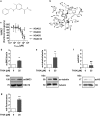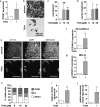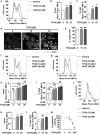The HDAC6/8/10 inhibitor TH34 induces DNA damage-mediated cell death in human high-grade neuroblastoma cell lines
- PMID: 29947893
- PMCID: PMC6063332
- DOI: 10.1007/s00204-018-2234-8
The HDAC6/8/10 inhibitor TH34 induces DNA damage-mediated cell death in human high-grade neuroblastoma cell lines
Abstract
High histone deacetylase (HDAC) 8 and HDAC10 expression levels have been identified as predictors of exceptionally poor outcomes in neuroblastoma, the most common extracranial solid tumor in childhood. HDAC8 inhibition synergizes with retinoic acid treatment to induce neuroblast maturation in vitro and to inhibit neuroblastoma xenograft growth in vivo. HDAC10 inhibition increases intracellular accumulation of chemotherapeutics through interference with lysosomal homeostasis, ultimately leading to cell death in cultured neuroblastoma cells. So far, no HDAC inhibitor covering HDAC8 and HDAC10 at micromolar concentrations without inhibiting HDACs 1, 2 and 3 has been described. Here, we introduce TH34 (3-(N-benzylamino)-4-methylbenzhydroxamic acid), a novel HDAC6/8/10 inhibitor for neuroblastoma therapy. TH34 is well-tolerated by non-transformed human skin fibroblasts at concentrations up to 25 µM and modestly impairs colony growth in medulloblastoma cell lines, but specifically induces caspase-dependent programmed cell death in a concentration-dependent manner in several human neuroblastoma cell lines. In addition to the induction of DNA double-strand breaks, HDAC6/8/10 inhibition also leads to mitotic aberrations and cell-cycle arrest. Neuroblastoma cells display elevated levels of neuronal differentiation markers, mirrored by formation of neurite-like outgrowths under maintained TH34 treatment. Eventually, after long-term treatment, all neuroblastoma cells undergo cell death. The combination of TH34 with plasma-achievable concentrations of retinoic acid, a drug applied in neuroblastoma therapy, synergistically inhibits colony growth (combination index (CI) < 0.1 for 10 µM of each). In summary, our study supports using selective HDAC inhibitors as targeted antineoplastic agents and underlines the therapeutic potential of selective HDAC6/8/10 inhibition in high-grade neuroblastoma.
Keywords: DNA repair; Differentiation; HDAC10; HDAC8; Selective histone deacetylase inhibitor; Targeted therapy.
Conflict of interest statement
The authors declare no conflicts of interest.
Figures





Similar articles
-
A kinome-wide RNAi screen identifies ALK as a target to sensitize neuroblastoma cells for HDAC8-inhibitor treatment.Cell Death Differ. 2018 Dec;25(12):2053-2070. doi: 10.1038/s41418-018-0080-0. Epub 2018 Mar 7. Cell Death Differ. 2018. PMID: 29515255 Free PMC article.
-
Design and Synthesis of Dihydroxamic Acids as HDAC6/8/10 Inhibitors.ChemMedChem. 2020 Jul 3;15(13):1163-1174. doi: 10.1002/cmdc.202000149. Epub 2020 May 13. ChemMedChem. 2020. PMID: 32348628 Free PMC article.
-
Dual role of HDAC10 in lysosomal exocytosis and DNA repair promotes neuroblastoma chemoresistance.Sci Rep. 2018 Jul 3;8(1):10039. doi: 10.1038/s41598-018-28265-5. Sci Rep. 2018. PMID: 29968769 Free PMC article.
-
Selective Inhibitors of Histone Deacetylase 10 (HDAC-10).Curr Med Chem. 2022;29(13):2306-2321. doi: 10.2174/0929867328666210901144658. Curr Med Chem. 2022. PMID: 34468295 Review.
-
Synthesis and applications of benzohydroxamic acid-based histone deacetylase inhibitors.Eur J Med Chem. 2017 Jul 28;135:174-195. doi: 10.1016/j.ejmech.2017.04.013. Epub 2017 Apr 10. Eur J Med Chem. 2017. PMID: 28453994 Review.
Cited by
-
HDAC6 Triggers the ATM-Dependent DNA Damage Response To Promote PRV Replication.Microbiol Spectr. 2023 Mar 23;11(2):e0213222. doi: 10.1128/spectrum.02132-22. Online ahead of print. Microbiol Spectr. 2023. PMID: 36951571 Free PMC article.
-
Natural Bioactive Compounds Targeting Histone Deacetylases in Human Cancers: Recent Updates.Molecules. 2022 Apr 15;27(8):2568. doi: 10.3390/molecules27082568. Molecules. 2022. PMID: 35458763 Free PMC article. Review.
-
HDAC8-Selective Inhibition by PCI-34051 Enhances the Anticancer Effects of ACY-241 in Ovarian Cancer Cells.Int J Mol Sci. 2022 Aug 3;23(15):8645. doi: 10.3390/ijms23158645. Int J Mol Sci. 2022. PMID: 35955780 Free PMC article.
-
Differentiating Neuroblastoma: A Systematic Review of the Retinoic Acid, Its Derivatives, and Synergistic Interactions.J Pers Med. 2021 Mar 16;11(3):211. doi: 10.3390/jpm11030211. J Pers Med. 2021. PMID: 33809565 Free PMC article. Review.
-
Anticancer Therapy with HDAC Inhibitors: Mechanism-Based Combination Strategies and Future Perspectives.Cancers (Basel). 2021 Feb 5;13(4):634. doi: 10.3390/cancers13040634. Cancers (Basel). 2021. PMID: 33562653 Free PMC article. Review.
References
-
- Adamson PC. All-trans-retinoic acid pharmacology and its impact on the treatment of acute promyelocytic leukemia. Oncologist. 1996;1(5):305–314. - PubMed
MeSH terms
Substances
LinkOut - more resources
Full Text Sources
Other Literature Sources
Medical

